

Ghoul. "Amine Discovered with the Goule", from the story of Sidi Nouman, of the Arabian Nights .
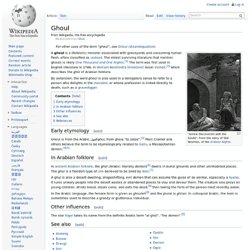
A ghoul is a (folkloric) monster associated with graveyards and consuming human flesh, often classified as undead . Lemurians. Lemuria (continent) Bunyip. The bunyip, or kianpraty,[1] is a large mythical creature from Aboriginal mythology, said to lurk in swamps, billabongs, creeks, riverbeds, and waterholes.

The origin of the word bunyip has been traced to the Wemba-Wemba or Wergaia language of Aboriginal people of South-Eastern Australia.[2][3] However, the bunyip appears to have formed part of traditional Aboriginal beliefs and stories throughout Australia, although its name varied according to tribal nomenclature.[5] In his 2001 book, writer Robert Holden identified at least nine regional variations for the creature known as the bunyip across Aboriginal Australia.
Chimaera. Chimaeras [ 1 ] are cartilaginous fish in the order Chimaeriformes , known informally as ghost sharks , ratfish (not to be confused with the rattails ), spookfish (not to be confused with the true spookfish of the family Opisthoproctidae ), or rabbitfishes (not to be confused with the true rabbitfishes of the family Siganidae ).

They may be the "oldest and most enigmatic groups of fishes alive today". [ 2 ] At one time a "diverse and abundant" group (based on the fossil record ), their closest living relatives are sharks , though in evolutionary terms they branched off from sharks nearly 400 million years ago and have remained isolated ever since. [ 2 ] Today they are largely confined to deep water. [ 2 ] Description and habits [ edit ] Chimaera egg Chimaeras live in temperate ocean floors down to 2,600 metres (8,500 ft) depth, with few occurring at depths shallower than 200 metres (660 ft).
Amazons. Eye of Horus. Devil's Footprints. The Devil's Footprints is a name given to a phenomenon that occurred in February 1855 around the Exe Estuary in East Devon and South Devon , England .
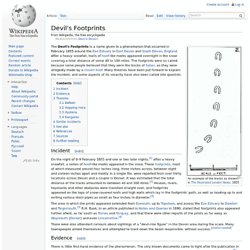
After a heavy snowfall, trails of hoof -like marks appeared overnight in the snow covering a total distance of some 40 to 100 miles. The footprints were so called because some people believed that they were the tracks of Satan , as they were allegedly made by a cloven hoof . Many theories have been put forward to explain the incident, and some aspects of its veracity have also been called into question. Loch Ness Monster. The Loch Ness Monster is a cryptid , reputedly a large unknown animal that is said to inhabit Loch Ness in the Scottish Highlands .
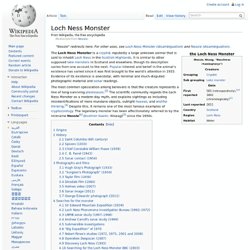
It is similar to other supposed lake monsters in Scotland and elsewhere, though its description varies from one account to the next. Popular interest and belief in the animal's existence has varied since it was first brought to the world's attention in 1933. Evidence of its existence is anecdotal, with minimal and much-disputed photographic material and sonar readings. Odin. Etymology[edit] Odin's name is formed from "óðr" and the suffix "-inn".

Old Norse had two different words spelled óðr, one an adjective and the other a noun. Bloody Mary (folklore) Divination rituals such as the one depicted on this early 20th century Halloweengreeting card, where a woman stares into a mirror in a darkened room to catch a glimpse of the face of her future husband, while a witch lurks in the shadows, may be one origin of the Bloody Mary legend.
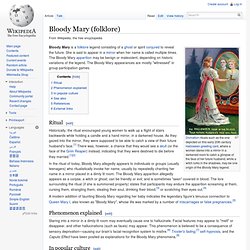
Bloody Mary is a folklore legend consisting of a ghost or spirit conjured to reveal the future. She is said to appear in a mirror when her name is called multiple times. The Bloody Mary apparition may be benign or malevolent, depending on historic variations of the legend. The Bloody Mary appearances are mostly "witnessed" in group participation games. Seti I. Menmaatre Seti I (or Sethos I as in Greek) was a pharaoh of the New Kingdom Nineteenth Dynasty of Egypt, the son of Ramesses I and Queen Sitre, and the father of Ramesses II.
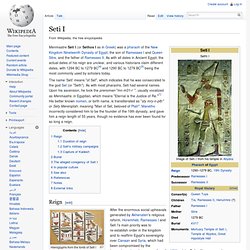
As with all dates in Ancient Egypt, the actual dates of his reign are unclear, and various historians claim different dates, with 1294 BC to 1279 BC[4] and 1290 BC to 1279 BC[5] being the most commonly used by scholars today. Reign[edit] Hieroglyphs from the tomb of Seti I After the enormous social upheavals generated by Akhenaten's religious reform, Horemheb, Ramesses I and Seti I's main priority was to re-establish order in the kingdom and to reaffirm Egypt's sovereignty over Canaan and Syria, which had been compromised by the increasing external pressures from the Hittite state. Seti, with energy and determination, confronted the Hittites several times in battle. Duration of reign[edit] Seti I's reign length was either 11 or 15 full years. Temple of Seti I at Abydos. Black magic. Black magic has traditionally referred to the use of supernatural powers for evil and selfish purposes. [ 1 ] In modern times, some find that the definition of "black magic" has been convoluted by people who define practices that they disapprove of as "black magic". [ 2 ] Black magic practices [ edit ] Within common mainstream religion, such as Christianity, there are certain taboos surrounding forms of magic.

Although culture may place certain forms in one side or another of this spectrum, there are in fact some cultural universals about free will. True name spells - the theory that knowing a person's true name allows control over that person, making this wrong for the same reason.